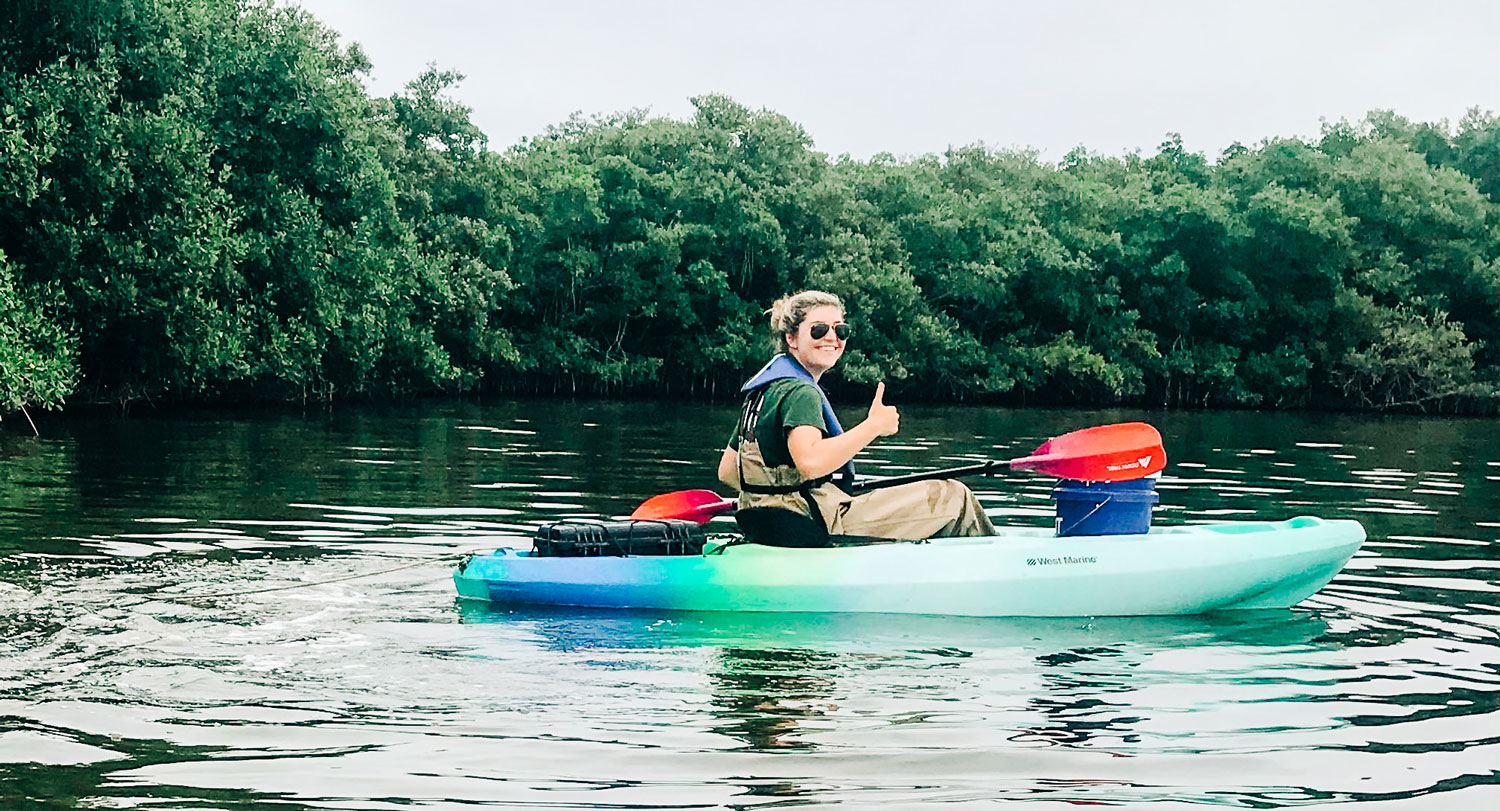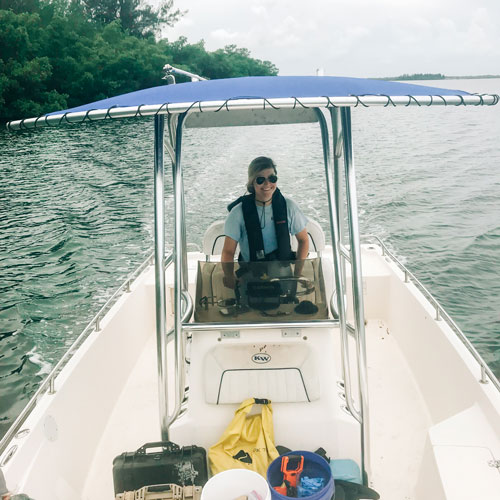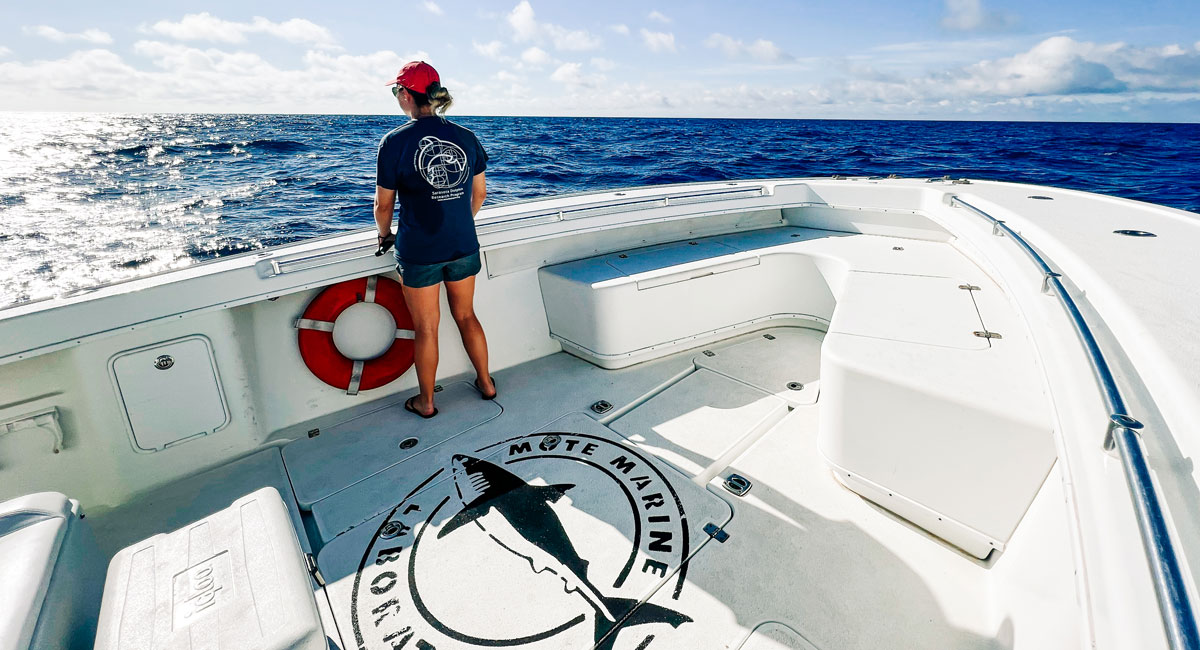
Since early childhood Ana Bishop has been captivated by the ocean and everything in it. Her favorite? Whales.
So when it was time for the 2021 marine science graduate to focus on her senior thesis, it made great sense to take direction from her professor. Erin Meyer-Gutbrod, assistant professor in the University of South Carolina’s School of Earth, Ocean and Environment, had been studying North Atlantic right whales since 2012.
Endangered to a scary degree — in 2020 there were an estimated 350 of them in the world — the mammal has been exhibiting changing behavior related to climate change for the past seven years. Bishop joined Meyer-Gutbrod’s research, and her thesis grew into a two-year project.
Now her work is published, and Bishop, at 23, is first author on an important study about whale fertility in Frontiers in Marine Science. Its June publication represents a triumph of long hours spent analyzing 40 years of raw data collected by the North Atlantic Right Whale Consortium and its affiliated partners. Bishop even took a computer coding course from Meyer-Gutbrod to do the work.

“The University of South Carolina completely changed my life,” says Bishop, who received an Academic Scholar – Excellence Award to enter the SCHC. “I do view it as my home. People wanted nothing else but to help me. Everyone there is so dedicated to helping the students.”
“Everything we learned helped me with that project,” said Bishop, who spent the year after graduation in Florida, interning for that state’s Fish and Wildlife Conservation Commission and the Sarasota Dolphin Research Program.
Because those internships were unpaid, Bishop worked in Irish pubs to support herself while continuing the research for the paper. It was a harried, stressful year, requiring late nights and efficient time management.
“There were times in the middle of the process where it seemed overwhelming and like it would never be finished,” she said. “I’m fresh out of undergrad and it’s not common to have someone my age doing this work. I’d have moments of self-doubt – I was working with professors and professionals in the field – and I didn’t know if I could produce what they wanted me to do. But I always knew this project was important and needed to be done.”
Here’s what Bishop, Meyer-Gutbrod, and their co-authors Leah M. Crowe and Phillip K. Hamilton were trying to nail down: How did habitat use and family genetics determine the fertility of female right whales?
Meyer-Gutbrod had already recognized that climate change played a large role in this research when she determined that warming water temperatures in the South were prompting some whales to leave the Gulf of Maine in the United States for the Gulf of St. Lawrence in Canada. Those colder waters had attracted the whales’ preferred prey: a species of plankton called Calanus finmarchicus, which provides more substantial food and thus a thicker, healthier blubber layer for successful calving.
Bishop’s research confirmed that fertility was significantly linked within maternal family lines, and those whales feeding in the Gulf of St. Lawrence were more successful giving birth. The paper, “Maternal Lineage and Habitat Use Patterns Explain Variation in the Fecundity of a Critically Endangered Baleen Whale,” is the first to show that the move seems to be benefitting the species.
“It was so fun to see a natural phenomenon happening and then do the work to chase down the explanation,” she said. “It felt amazing to uncover the mechanisms behind important whale behaviors in real time.”
Meyer-Gutbrod can vouch for the importance of her student’s work. “Ana’s research gives some critical insight into whether this habitat is beneficial for these whales. This work is really important for helping researchers and managers predict whether right whales will continue to use this new habitat, or whether they will need to find a new place to feed.”
“I would really love to see everyone come together and agree to commit to make a change together — government, corporations, average individuals — so we can try to protect and heal the planet for the next generation.”
Still, the reality of the discovery isn’t that happy. The Gulf of St. Lawrence is busy with trade ships and fishing boats. Right whales often are injured or killed in “vessel strikes” and become entangled in fishing gear, which can cut, infect and kill them.
Accidents have become so frequent that female whales are living 45 years instead of the 70 years scientists think is their average lifespan, according to information on the National Oceanic and Atmospheric Administration’s website. While the United States and Canada have passed laws protecting whales by regulating ship speeds and fishing gear usage, the new measures have not been enough for the right whale population to recover.
With right whales spending more time than ever in Canadian waters, Bishop says Canada needs to act fast: The North Atlantic right whale is one of the most critically endangered baleen whale species in the world. More aggressive laws that would slow boats down and force the creation of safe fishing gear are necessary, she believes.
“The population is so small; there isn’t much wiggle room,” she said. “Scientists, fishermen, government policy makers and environmental managers need to move quickly.”
A Baltimore native who grew up visiting that city’s famed aquarium and vacationing at Ocean City Beach, Bishop says marine life never fails to fascinate her. During her Florida internships she worked with manatees and dolphins and saw her first hammerhead shark and spotted eagle ray.
“Every time I see a creature I grew up learning about, it just takes my breath away,” she said. Whales – with their intelligence and complexity – interest her most.

“They’re so majestic. They’re such an old animal. And the way they’ve learned to navigate their environment is just so fascinating. It’s amazing our world has an animal like that.”
Unsurprisingly, Bishop wants to work researching and protecting endangered marine animals. Currently in her first year of Duke University’s master of environmental management program, she envisions a career with a federal agency, helping make policy. She predicts much of her work will be related to climate change. It’s a topic that “would inevitably come up” in her environmental courses at the university.
“We learned how prevalent and big a problem it is,” she said. “It motivated me to do something about it.”
Change needs to happen globally, she emphasizes.
“I would really love to see everyone come together and agree to commit to make a change together — government, corporations, average individuals — so we can try to protect and heal the planet for the next generation,” she said. “And quit putting the amount of stress on the environment that we have.”